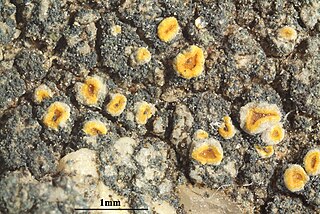Lecania leprosa is a species of saxicolous (rock-dwelling), crustose lichen in the family Ramalinaceae. It occurs in Eastern Europe.
Buelliella lecanorae is a species of lichenicolous (lichen-eating) fungus in the class Dothideomycetes. It is found in a few locations in Estonia and in Crimea, where it grows parasitically on members of the Lecanora subfusca species group.
Opegrapha verseghyklarae is a little-known species of lichenicolous (lichen-eating) fungus in the family Opegraphaceae. It is found in the Russian Far East, where it grows on the thalli and apothecia of the crustose lichen Ochrolechia pallescens.

Thelomma santessonii, the tan nipple lichen, is a species of saxicolous (rock-dwelling), crustose lichen in the family Caliciaceae. Found in northern North America, it was formally described as a new species in 1976 by lichenologist Leif Tibell. It is endemic to the coast and islands of Southern California and Baja California in Mexico.
Lecania juniperi is a rare species of corticolous (bark-dwelling), crustose lichen in the family Ramalinaceae. Discovered on Juniperus phoenicea shrubs in the coastal region of Portugal, it was formally described as a new species in 2012. Despite its resemblance to Lecania cyrtella, L. juniperi stands out due to its warted and sorediate thallus, larger apothecia, and distinct ascospores.

Verrucaria viridula is a common and widely distributed species of saxicolous (rock-dwelling), crustose lichen in the family Verrucariaceae. Although it is a somewhat morphologically variable species, two persistent distinguishing characteristics are its relatively large perithecia, which are often curved into a beak, and its large ascospores.
Caloplaca streimannii is a little-known species of saxicolous (rock-dwelling), crustose lichen in the family Teloschistaceae. Found in New South Wales, Australia, it is characterised by its powdery soredious mass and numerous tiny apothecia.
Caloplaca patagoniensis is a species of lignicolous (wood-dwelling), crustose lichen in the family Teloschistaceae. It is found in Chile. It forms small thallus patches, with distinctive areoles that change from whitish or greyish-yellow to deep orange or brownish-orange, often covered by a bright orange blastidious mass. Its fruiting bodies (apothecia) are dark reddish-orange and initially immersed in the substrate, while its spores are ellipsoid to elongated, and the species contains parietin, turning purple when exposed to a potassium hydroxide solution.
Caloplaca ulleungensis is a species of saxicolous (rock-dwelling), crustose lichen in the family Teloschistaceae. It is found in South Korea, particularly on Ulleungdo and Jeju Islands.
Pyrenodesmia micromarina is a species of saxicolous (rock-dwelling), crustose lichen in the family Teloschistaceae. It is found in the Eastern Mediterranean, specifically along the coasts of the Black Sea and the Sea of Marmara in Russia, Turkey, and Ukraine. It grows on coastal rocks and occasionally concrete, often in Mediterranean scrub vegetation.

Flavoplaca austrocitrina is a species of saxicolous (rock-dwelling), crustose lichen in the family Teloschistaceae. It is widely distributed in Europe, and has also been recorded in South America.

Polycauliona coralloides, the coral firedot lichen, is a species of small fruticose (bushy), saxicolous (rock-dwelling) lichen in the family Teloschistaceae. First formally described in 1866, it was later shuffled to a few different genera in its taxonomic history before ending up in Polycauliona, a genus resurrected from taxonomic obscurity in the molecular phylogenetics era. The lichen occurs on seaside rocks in the intertidal spray zone of California and northwestern Mexico. The species is readily recognized due to its distinctive coral-like form–its thallus grows as a tangle of orange, filamentous branches.
Caloplaca akbarica, a species of lichen saxicolous (rock-dwelling), crustose lichen described in 2002. Found in Tajikistan, it has a rosette-shaped, lobate thallus, and apothecia that are distinctly pruinose. It was formally described as a new species in 2002 by the lichenologists Imomnazar Kudratov and Oleksandr Khodosovtsev.

Flavoplaca oasis is a species of saxicolous (rock-dwelling), crustose lichen in the family Teloschistaceae. It is widely distributed across Europe, and has been reported in Western Asia, China, and North Africa.

Kuettlingeria soralifera is a saxicolous (rock-dwelling), crustose lichen species in the family Teloschistaceae, first described in 2006. It is similar to Kuettlingeria xerica but distinguished by the presence of soredia on its thallus.
Caloplaca lecanorocarpa is a species of saxicolous (rock-dwelling), crustose lichen in the family Teloschistaceae. Found in Brazil, it was formally described as a new species in 2016 by the lichenologists André Aptroot and Marcela Cáceres. It is named for its overall appearance to lichens in the Lecanora subfusca species complex.

Opegrapha physciaria is a species of lichenicolous (lichen-dwelling) fungus in the family Opegraphaceae. It was first formally described as a new species in 1897 by Finnish lichenologist William Nylander, who placed it in the genus Lecidea. David Hawksworth and Brian J. Coppins transferred it to the genus Opegrapha in 1992.

Kuettlingeria neotaurica is a species of saxicolous (rock-dwelling), crustose lichen in the family Teloschistaceae.

Acarospora stapfiana, the hoary cobblestone lichen, is a lichenicolous (lichen-dwelling) lichen species in the family Acarosporaceae. It is known for its parasitic relationship with members of the genus Caloplaca. The species has a unique life cycle in which it starts as a juvenile non-lichenised fungus before forming a fully lichenised thallus. It is found in Asia and North America, where it grows on calcareous rocks.
Xanthocarpia diffusa is a species of saxicolous (rock-dwelling) crustose lichen in the family Teloschistaceae. First described in 2011 from coastal rocks in Georgia, it is characterised by its yellow to greyish thallus with distinctive diffuse margins often bordered by a pale prothallus. The species primarily occurs along coastal areas of the Black Sea region, with some isolated populations in the Mediterranean region, where it grows on damp siliceous rocks, particularly around seepage zones and in areas exposed to sea spray. Though initially described in the genus Caloplaca, molecular phylogenetics studies led to its transfer to Xanthocarpia in 2013.








